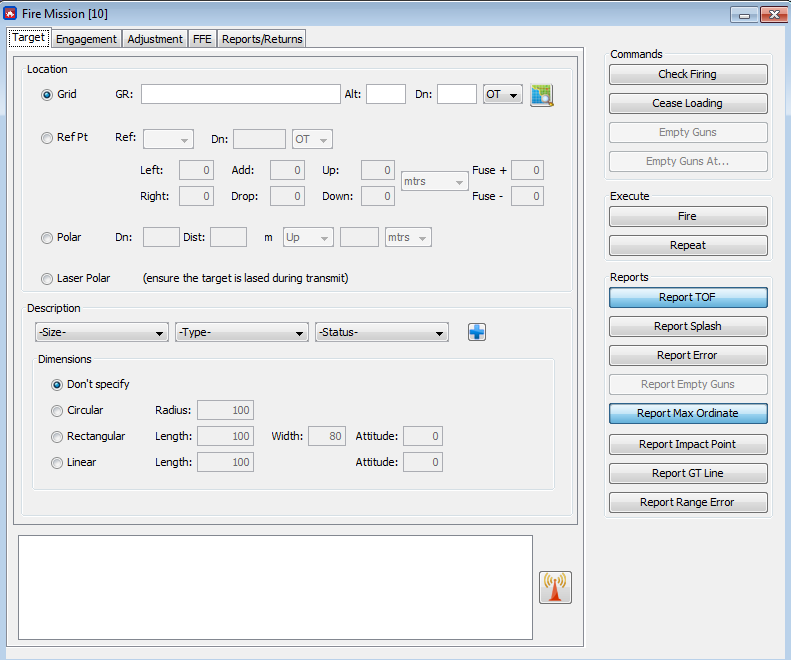Target Tab
The 'Target' tab can be used to specify the location, description, and dimensions of the target.

∆ Image 3b: Target Tab window |
- Target location .There are four methods to specify the
location of the target.
- Grid .This allows the specification of the
eight-figure grid reference of the target, as well the target altitude
(m), and the direction to the target (mils).
Note:The From Map button
The altitude of the target is in meters above sea-level (not above ground level). If the altitude field is left blank, ground level will be used by default. When choosing the direction, the user may choose whether to specify the direction as the observer-target (OT) or gun-target (GT) direction. Make this choice by selecting the relevant option form the drop-down box. allows the users to select the position from the VBS3 2D map by just c
licking on the required location.
allows the users to select the position from the VBS3 2D map by just c
licking on the required location.

∆ Image 3b1: Dialog box indicating Fires waiting for a grid location
Note:
When clicked on the from map button, VBS3 will move to the 2D map view. Then users can select a desired position of the VBS3 2D Map. The grid location of that position will be automatically entered to the Grid Text box.
- Reference point .If a target has been previously recorded, the user may use that target as a reference point. To do this, select the target from the ref pt dropdown list, and enter the current direction to the target (GT or OT). The user may also specify an adjustment off the previously recorded target by using the Adjustment fields. See the 'Adjustments' tab section for more details on how to do this.
- Polar .The user may use polar coordinates from their position to specify the target location. Note: it is important to send a current and correct Locstat to the gunline before sending a polar target location. To send a polar reference, first enter the direction from the observer to the target in mils, followed by the observer's distance to the target. There is the option of also specifying a relative elevation to the target. This can be in metres or mils and is relative to the observer's position.
- Laser Polar .If the observer has a laser designator within the VBS3 scenario, it can be used to facilitate laser designation as a target location method. Sending this transmission will inform the fire asset to stand by for a data transmission containing coordinates that the observer is lasing. Please see the laser designation section for more information on using this method.
- Grid .This allows the specification of the
eight-figure grid reference of the target, as well the target altitude
(m), and the direction to the target (mils).
- Target description . This is used to convey to the guns
what it is they are firing at. It will affect the rounds and the fuses used
by the guns. The observer may specify three attributes of the target; these
are size, type, and status. By clicking the additional button, the observer
may send several separate descriptions of the target. This will add an
additional line in the GUI.
- Size. This specifies the size of the unit and can be the unit size (such as Sect, Pl, and Bty etc.) or a numerical number.
- Type. This specifies a type of unit or object being fired at, for example, it could be infantry, armoured, buildings, trucks, rotary wing etc.
- Status. This describes what the target is currently doing and how well defended it is likely to be from artillery. Examples include moving, in open, dug in no OHP, dug in OHP, under cover etc.
- Dimensions .This is used to specify how big the
footprint of the target is on the ground. The observer should select the
option that most closely resembles the unit's geographic position from the
options Circular, Rectangular, and Linear.
- Circular Specify the radius of the circle which would surround the target.
- Rectangular .Specify the length and width of the target and the attitude of the target (mils). Note, if the length is five times greater than the width of the target, it is usual to describe the target as a linear formation, rather than rectangular.
- Linear . Specify the length of the target (m), and the attitude of the target (mils).
